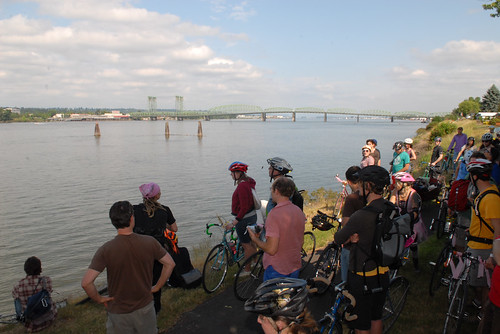As the Portland region’s freeway planners lick their wounds over the death of the Columbia River Crossing, one of the region’s longstanding anti-freeway warriors is seizing the moment of quiet to push a new plan that he says would be far less expensive.
Jim Howell, a longtime citizen activist and former TriMet bus planner who helped lead opposition to both the Mount Hood Freeway and the Columbia River Crossing, has an out-of-the-box idea:
- Scrap most of the highway enlargements that were part of the Columbia River Crossing.
- Build a new eight-lane highway bridge immediately upstream of the current Interstate Bridge.
- Repurpose the Interstate Bridge as a two-lane local street, a light rail crossing and a pair of dedicated cycle tracks.
Interesting? You bet. Howell, the volunteer strategic planning director for the Association of Oregon Rail and Transit Advocates, says the whole thing would cost $1 billion, compared to the Columbia River Crossing plan’s $3.1 to $3.5 billion.
Howell calls his idea the “Common Sense Alternative II,” since it builds on the Common Sense Alternative that CRC opponents have touted for years as a cheaper way to improve connections across the river. The main difference between the “CSA I” and “CSA II” is the idea of keeping the existing bridge (which actually consists of two separate spans, one northbound and one southbound) in service, but not as a freeway. Here’s how the space on the bridges might be allocated:
Another key difference: instead of running light rail through downtown Vancouver, this plan would end the Yellow Line south of downtown, where the city has been hoping to develop a new waterfront residential district. From there, rail passengers could connect to Clark County’s C-Tran buses:
Here’s what Hayden Island, much of which would have been bulldozed to build a massive highway interchange, might look like under Howell’s proposal:
“To me it’s ridiculous to have a community whose only access is the interstate freeway,” Howell said. “You cannot get to the Hayden Island, which is a Portland neighborhood, without getting on the interstate freeway. That’s a problem that has to be solved. And you solve it with a local bridge or, in this case, by repurposing a freeway bridge.”
“There’s clearly a problem, and it’s going to get worse, but we certainly don’t have to spend three and a half billion dollars to fix the problem.”
— Jim Howell
I asked Howell whether, after all the millions of dollars spent on failing to reach a compromise, it’s worth pursuing a somewhat similar plan that, though it doesn’t include major interchange expansions, still includes a brand-new highway bridge and light rail.
“I don’t buy that there is no problem and you should walk away from it,” Howell said. “There’s clearly a problem, and it’s going to get worse, but we certainly don’t have to spend three and a half billion dollars to fix the problem.”
Howell says congestion on Interstate 5 does in fact harm the region, because there’s currently no way to avoid it. But he argues that the solution isn’t to greatly expand highway capacity but to give people options — rail, bikes, local streets — to get from one city to the other without getting on a freeway, which should be mostly reserved for freight and long-distance travel, not local traffic.
Another political advantage of the CSA II, he thinks, is that at $1 billion, it’s cheap enough to be achieved without tolling cars.
What about the frequently cited concern that the current I-5 spans would crumble in an earthquake?
“The only earthquake that’s going to have an impact on that bridge is one with an epicenter right underneath it, and the odds of that are very small, or the big one, the 9-point subduction quake, in which case the last thing we’ll be worried about is those two bridges,” Howell said. “Half the buildings in Portland would come down.”
Here’s Howell’s rough list of the costs of his concept, as compared to the defunct CRC megaproject:
Howell is one of a handful of amateur unpaid transportation wonks in Portland who are accustomed to preparing detailed plans that may not be likely to be built.
But one of the things about Portland is that sometimes, crazy plans — MAX light rail, a modern streetcar, a citywide network for bicycle transportation — actually happen. And whatever the merits of this idea, Howell has a history of being on the right side of history. Maybe this is a concept that, unlike the CRC, will pass the test of time.






